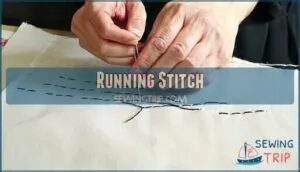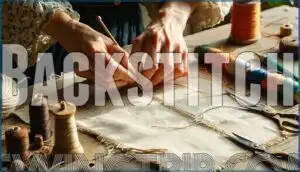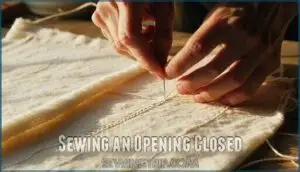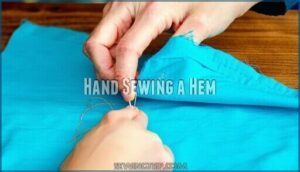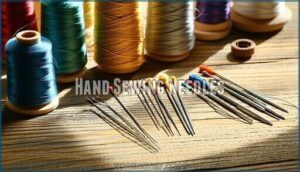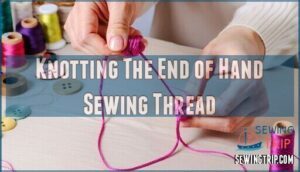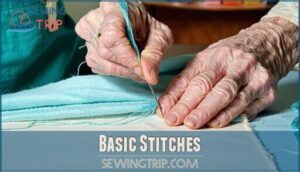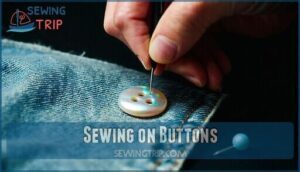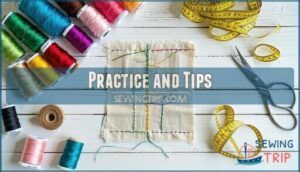This site is supported by our readers. We may earn a commission, at no cost to you, if you purchase through links.
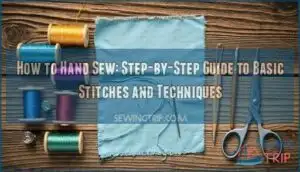
The running stitch creates quick seams by weaving in and out of fabric in even intervals. For stronger seams, use the backstitch, which overlaps each stitch for durability. Practice on cotton scraps first—it’s forgiving and easy to work with. Keep your stitches consistent in size and spacing for professional-looking results.
The beauty of hand sewing lies in its portability and precision, letting you create and repair anywhere. Once you’ve nailed these basics, you’ll discover specialized techniques that transform simple stitches into invisible hems and decorative finishes.
Table Of Contents
Key Takeaways
- Start with quality basics – You’ll need sharp fabric scissors, various needle sizes, matching thread, and a thimble to protect your fingers during longer projects.
- Master two essential stitches first – Learn the running stitch for quick seams and the backstitch for durable, strong connections that won’t come apart under stress.
- Practice proper technique from the start – Keep your stitches consistent in size and spacing, work in good lighting, and always prewash your fabric to prevent shrinking.
- Begin with forgiving materials – Start practicing on cotton scraps since they’re easy to work with and forgiving of mistakes while you’re building your skills.
Basic Sewing Tools
Before diving into your first hand sewing project, gathering the right hand sewing supplies makes all the difference. You’ll need sharp fabric scissors for clean cuts and a variety of sewing needle sizes – smaller numbers mean thicker needles for heavier fabric. A Needle Size Guide becomes your best friend when matching needles to different fabric weights. Understanding needle size conventions is essential for selecting the right needle for your fabric.
Choose quality thread that matches your material, and don’t skip the thimble for finger protection during lengthy projects. Marking tools like water-soluble pens help you trace patterns accurately, while pins hold pieces together as you work. Keep measuring tape handy for precise measurements, and consider beeswax to prevent thread tangling.
These basic tools form your foundation for successful hand sewing adventures.
Hand Sewing a Seam
Hand sewing a seam connects two pieces of fabric together using basic stitches that create strong, reliable joints.
You’ll use either a running stitch for quick work or a backstitch for extra durability, depending on your project’s needs.
Running Stitch
With your basic tools ready, the running stitch becomes your foundation for hand sewing strong seams. This fundamental technique creates evenly spaced stitches that look like a dashed line across your fabric.
The running stitch works well for various sewing projects, from simple seams to quilting applications. Your stitch length determines the final appearance and strength of your work.
Here’s how to master this essential hand sewing stitch:
- Start your seam – Bring the needle up through both fabric layers near your seam line
- Create consistent spacing – Move forward one stitch length and push the needle back down through the fabric
- Maintain rhythm – Repeat this forward motion, keeping your stitches and spaces roughly equal in size
For gathering fabric or curved seams, shorter stitches provide better control. Longer stitches work perfectly for basting or temporary joins. Your fabric choice affects stitch visibility, so practice on scraps first to find your ideal spacing. The running stitch is also used in sashiko quilting projects.
Backstitch
When precision matters most, backstitch delivers exceptional strength for hand sewing projects. This reliable technique creates continuous lines by moving forward one stitch length, then doubling back to fill gaps.
Unlike basic running stitches, backstitch variations offer outstanding durability for securing seams. Consider purchasing quality needles for ideal results.
Master this beginner-friendly method for backstitch embroidery and decorative backstitch work that won’t unravel under stress.
Sewing an Opening Closed
Successfully closing an opening requires mastering the invisible closure technique that seamlessly joins fabrics together. The ladder stitch creates nearly invisible seams perfect for handsewing projects.
Essential Steps for Perfect Closure:
- Fold raw edges – Press edges inside along seam allowances to create clean fold lines
- Start the ladder stitch – Insert needle up through one folded edge, catching only a few threads
- Cross to opposite side – Move needle directly across to matching point on opposite fold
- Maintain even spacing – Keep stitches consistent, roughly 1/8 inch apart for strength
- Secure final stitches – Weave needle under existing threads and knot tightly before trimming
This slip stitch method prevents puckering while matching seams perfectly, creating professional-looking results in hand sewing projects. Using the appropriate needle is essential for achieving the best results.
Hand Sewing a Hem
Hemming creates a polished edge by folding fabric and securing it with stitches. You’ll learn three essential hem techniques that work for different fabric types and project needs.
Whip Stitch Hem
The whip stitch creates strong, durable hems through diagonal stitching that accommodates fabric thickness well. This hand sewing technique offers excellent seam security, making it perfect for jeans hemming where durability matters most.
Strong diagonal stitches make whip stitch the go-to choice for heavy fabrics and lasting durability
- Hem Durability: Diagonal threads distribute stress evenly across fabric layers
- Fabric Thickness: Works well on heavy materials like denim and canvas
- Seam Security: Overlapping stitches prevent unraveling under tension
- Jeans Hemming: Ideal for thick seams that need professional-looking finish
- Quick Technique: Faster than blind hemming while maintaining clean appearance
Blind Hem Stitch
The blind hem stitch creates invisible hems that look professionally finished. This hand sewing technique works perfectly for fabric types like cotton, wool, and denim. You’ll fold the hem twice, then catch tiny bits of the main fabric with your needle while staying hidden in the fold. A key characteristic is that it allows the fabric to hang freely without visible stitches.
| Step | Action |
|---|---|
| 1 | Fold fabric up 1-1.25 inches, press flat |
| 2 | Take small stitches every 1/4 inch through fold |
| 3 | Catch only 1-2 threads of outer fabric |
This hand sewing stitch works great for curved hems on skirts and dresses. Master this technique and you’ll have sophisticated techniques for creating hems that rival store-bought garments. The stitch variations include single or double threading for different fabric weights.
Blanket Stitch Hem
The blanket stitch adds decorative flair while securing your hem. Fold fabric to desired length and thread your needle. Start from behind the hem, bringing the needle up through both layers. Create consistent stitch spacing for edge durability. Loop thread under needle tip before pulling tight – this forms the signature decorative edge.
Master the cornering technique by maintaining steady thread thickness for clean decorative variations around curves.
- Master the cornering technique by maintaining steady thread thickness for clean decorative variations around curves.
This hand sewing technique offers professional results with proper stitch spacing control.
Hand Sewing Needles
Choosing the right sewing needle makes all the difference in your hand sewing success. Think of needles as your faithful partners in every project—they need to match both your thread and fabric perfectly.
Needle Size Guide: Sharps needles work best for general hand sewing, ranging from size 1 (thickest) to 12 (finest). Remember, higher numbers mean finer needles. For most cotton fabrics, size 5–8 works well.
Threading Techniques: Match your thread thickness to the needle eye—it should fill about 70% of the space. Too thick causes friction; too thin creates loose stitches.
Fabric Compatibility: Delicate silks need fine needles (size 10–12), while denim requires sturdy size 3–5 needles. Needlepoint needles with blunt tips work for canvas projects. For cross-stitching projects, consider using tapestry needles with their long eye and blunt tip.
Needle Storage: Keep needles organized in a pin cushion or magnetic holder. Replace them every 8–12 hours of use when they become dull or bent.
Quality sewing needles transform your hand sewing techniques from frustrating to enjoyable.
Knotting The End of Hand Sewing Thread
Now that you’ve selected the right needle for your hand sewing project, properly securing your thread becomes your next priority. Thread knot types vary in strength and appearance, so choosing the right approach matters. A well-tied knot prevents your stitches from pulling through the fabric and keeps your work intact.
Here’s how to create a secure knot for hand sewing:
- Cut your thread at least twice the length you’ll need for sewing
- Thread the needle and pull one end longer than the other
- Wrap the thread around your index finger twice
- Roll the loops off your finger while pinching them together
- Pull tight to form a small, firm knot at the thread’s end
Knot size matters – you want it large enough to catch the fabric but small enough to pull through easily. Preventing loose knots starts with tying securely and testing the hold. When knotting thicker threads, you might need extra wraps for adequate grip. This foundation ensures your hand sewing techniques produce lasting results.
Basic Stitches
Anyone can master the essential Basic Stitches that form the backbone of Hand Sewing. These fundamental Hand Sewing Stitches serve as your toolkit for countless projects.
The Running Stitch Uses include quick seaming and basting, while Backstitch Strength makes it perfect for durable seams that won’t come apart. Slip Stitch Uses shine when you need invisible closures or hems. Basting Techniques help you temporarily hold fabric pieces before permanent stitching, and Zig-Zag Application accommodates stretchy fabrics beautifully. A thimble is an essential tool to protect fingers effectively.
Here are three Beginner Stitches that’ll get you started:
- Running Stitch: Creates simple, straight seams with basic in-and-out needle movement
- Backstitch: Doubles back on itself for continuous, strong lines that won’t break under stress
- Slip Stitch: Joins fabric edges invisibly by catching tiny bits of each piece alternately
Master these core Sewing Techniques first. They’re building blocks for every hand-sewn project you’ll tackle.
Sewing on Buttons
Mastery in button attachment transforms basic garments into polished pieces. You’ll encounter two main button types: flat buttons with holes and shank buttons with stems underneath.
Button placement requires careful measuring—mark your spot with a pin before starting. For flat buttons, thread your needle and create a small anchor stitch beneath where the button will sit. Pass the needle up through one hole, down through another, repeating 4-6 times. Create reinforcement stitches by wrapping thread around the button’s stem before securing with knots underneath.
Shank buttons need only one hole, making them easier for beginners. Use buttonhole stitches or simple running stitches to secure them firmly. Whether attaching decorative buttons or functional ones, consistent tension prevents loose attachments. Hand sewing buttons properly ensures they’ll withstand regular use without popping off unexpectedly.
Practice and Tips
Your hand sewing journey’s success depends on building solid foundations through consistent practice and smart techniques. Master these beginner sewing fundamentals by focusing on four essential areas that’ll transform your stitching skills.
Here are four essential tips to help you improve your hand sewing techniques:
- Fabric Prewashing: Always wash your fabric before starting any project. This prevents shrinking and color bleeding that could ruin finished work.
- Stitching Direction: Work from right to left if you’re right-handed, left to right if you’re left-handed. This natural flow reduces hand fatigue and improves stitch consistency.
- Beginner Fabrics: Start with cotton, linen, or flannel. These materials forgive mistakes and respond well to basic sewing stitches while you’re learning.
- Avoiding Shortcuts: Use proper tools and take time with each stitch. Rushing leads to uneven seams and frustrating rework.
The ironing benefits can’t be overstated—smooth fabric creates cleaner stitch lines. Practice these hand sewing techniques regularly on scraps before tackling actual projects. Remember, even experienced sewers started with wobbly running stitches.
Frequently Asked Questions (FAQs)
What are some common mistakes to avoid when hand sewing?
Picture yourself as a sewing surgeon making critical errors in the operating room – yikes! **Don’t use dull needles, skip prewashing fabric, pull thread too tight, or neglect proper lighting.
These mistakes create puckered seams and frustrating results.
How do I choose the right thread for my hand sewing project?
Choose thread that matches your fabric weight and color. Cotton thread works best for cotton fabrics, while polyester offers durability for mixed materials.
Test thread strength by gently pulling—it shouldn’t break easily during stitching.
How do you repair a tear in fabric?
Like mending a broken bridge, you’ll carefully align torn edges and secure them with small, even stitches. Use matching thread and backstitch along the tear for strength and durability.
What thread type works best for hand sewing?
All-purpose polyester or cotton thread works best for most hand sewing projects. You’ll want medium-weight thread that’s strong enough to handle tension but won’t overwhelm delicate fabrics or create bulky seams.
How can you prevent hand-sewn seams from unraveling?
Frayed edges dance loose like untamed threads seeking freedom.
You’ll secure hand-sewn seams by backstitching at start and end points, using French seams for delicate fabrics, or applying pinking shears to cut zigzag edges that resist unraveling naturally.
How do you sew stretchy or knit fabrics by hand?
Use a catch stitch or zig-zag stitch for stretchy fabrics. These create flexible seams that won’t break when the fabric stretches. Pull gently and don’t over-tighten threads.
What’s the best way to hide hand stitches?
To hide hand stitches effectively, you’ll want to master the slip stitch and blind hem stitch.
These techniques create nearly invisible seams by catching only a few fabric threads on the visible side while securing the majority of the stitch underneath.
Conclusion
Despite what you might think, learning how to hand sew doesn’t require expensive machines or years of training. With just basic tools and these fundamental techniques, you’re equipped to tackle repairs, alterations, and simple projects anywhere.
Practice these stitches regularly to build muscle memory and confidence. Remember, even professional seamstresses started with wobbly running stitches.
Your skills will improve with each project, transforming you from a complete beginner into someone who can hand sew with precision and pride.

